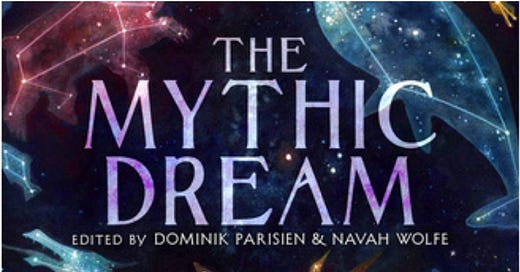This is the newsletter I am writing the week before I am moving to New Mexico. It may be somewhat scattered therefore — my god, travel agita is real and it is very terrible — but also I wouldn’t miss telling you about the new collection I have a story in, which is out tomorrow! And what better time to take a moment to talk about how I think about retelling very old stories (like, oh, going on a long questish journey…)
THE MYTHIC DREAM (SAGA PRESS) — OUT TOMORROW (SEPTEMBER 3, 2019)!
Last year, the brilliant (Hugo-award-winning!) editor Navah Wolfe approached me and asked if I wanted to write a story for an anthology she was editing with the equally brilliant Dominik Parisien. I loved the first two anthologies they’d edited together — The Starlit Wood and Robots vs. Fairies — and I was really honored to get to write for this one, especially when I heard that the theme was ‘take a myth and retell it any way you like’.

The list of authors who have written for this thing is incredible. I get to have a story alongside Amal el-Mohtar, Sarah Gailey, Rebecca Roanhorse, J.Y. Yang, John Chu, Ann Leckie, T. Kingfisher, Carmen Maria Machado … and this is just a quick spin through the table of contents. I can’t wait to read everyone else’s interpretations.
As for me, I ended up writing a space opera/cyberpunk remix of the Fragmentary Hymns to Inanna (specifically ‘Inanna Takes Command of Heaven’, ‘Inanna and Enki’, and a whole bunch of praise hymns). My story is called ‘Labbatu Takes Command of the Flagship Heaven Dwells Within’, and it is both extremely on brand and, ah. Much filthier than my usual linguistic register, but hey, Inanna is the goddess of sex and war, okay?
The book is released in stores tomorrow, and you can buy it anywhere books are sold, as well as on the internet.
APPROACHING A RETELLING
The myth I chose to retell is not the usual Inanna myth — that’s the Inanna Descends to the Underworld one, with Ereshkigal in — and I chose this one sort of because I wanted to do something unusual, unexpected, a little bit sideways; and sort of because I wanted to have something to work with that was fragmentary. The story I wrote is fragmentary: it’s told in poems and news-clips and oral folktale and straight-up third person present narrative sections. I wanted it to feel old, reconstructed. In essence, I wanted it to feel retold.
Finding a myth I wanted to work with was quite difficult. My home culture is Ashkenazi Jewish, and of course we have myths — tons of them — and honestly someday I’d love to write a golem story, or a take on the Fools of Chelm. But for this, for the first time I played in this particular sort of retelling-space, I wanted to go a little outside myself. Take the pressure off. Which meant also really not wanting to step into anyone else’s home culture, too closely. I was going to take something apart, and I wanted it to be something that, well. Was already apart, so I wasn’t doing further damage.
Thus: fragments, Sumerian mythos, something used a thousand thousand times and partially forgotten already.
Something I could reassemble while leaving fragmentary.
I’ve done retellings before, of course. One of my favorite short stories, “Fear Death by Water”, published in Unlikely Story in 2017, is a straight-up retelling of the death of Caesar. And the T.S. Eliot poem, also. I took whole passages from Vergil and ran them through a space opera lens, and the red-painted faces of the religious/judicial officials in the story are straight out of Roman priests of Jupiter and what they wore symbolically. But I’ve studied Roman history for more than half my life, and Caesar is practically public domain.
What interests me about the similarities between the two stories, though, is that I find such power in using unusual voice, fragmentary structure, and composite arrangement when I’m doing a retelling. It feels correct to me. I wonder if it still would at longer length — if a retelling I’d write in novel or novella format would still be structurally full of this kind of slippage.
But then I’m no Hal Duncan, and his Ink and Vellum are beyond me, so really it’s been done, hasn’t it?
There is something there, though. Slippage, and retellings. Composites and layers. Singing the story again (in hopes it might turn out this time.)
That’s what I’ve got for you tonight, o friends of the newsletter. This post is September’s first public post. If you’d like to get another post next Monday, on beginning new projects, please subscribe. Otherwise, see you in two weeks, and on the other side of the country.

